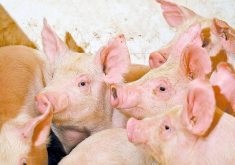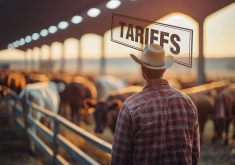It seems not all reindeer pull Santa’s sleigh. Some can be found just ruminating on select farms throughout Alberta.
Ten reindeer farms housing about 135 animals have organized themselves into the Alberta Reindeer Association. One member is Amber Lane Game farm near Leduc, run by Herman, Alice and their son Brendan Bulten. They have a small herd of 10 reindeer.
Most of the world’s reindeer are domesticated and have been raised for centuries in Norway, Sweden, Russia and Mongolia. In Alberta reindeer are mainly raised for Christmas display purposes. Some reindeer farmers have trained the animals to pull sleighs, and bring them to Christmas-related events throughout the province, where children and adults can meet the animals.
Read Also

Horns aren’t unlocking anytime soon on livestock transport standards
Standards good enough meet the definition of “humane” animal transportation still vary widely between what what industry wants, what animal rights advocates want and, between the two, what federal regulators decide is good enough.
The Bultens say children love meeting and petting the animals, and adults are equally fascinated by the deer. “A lot of people ask us if the animals are real,” said Brendan.
Members of the Bulten reindeer herd have participated in fairs in St. Albert and Leduc and were featured on an Edmontonbased television channel the day before Christmas.
In other countries, such as Norway, the meat is widely consumed, and in some markets, the meat can fetch a good price. “We simply haven’t done a lot to develop the reindeer meat market in Alberta because we don’t have the number of animals,” said Herman.
The Bultens have had several animals born on their farm, and originally began with a pair of reindeer. They’ve added to their small herd by breeding the animals, and buying some from other producers.
Reindeer eat hay, alfalfa and a grain mixed with peas and beet pulp, as they seem to require tannin in their diet to stay healthy. A full-grown reindeer is about shoulder height and covered with a dense, soft fur that feels like felt. The animals have dry noses which are fully covered with fur, and wide hooves designed to help the animal walk on snowy terrain. A reindeer takes three years to be fully mature and usually calve in their third year. Reindeer are fairly quiet, and are not as protective of their calves as some other animals, said Herman.
Unlike many other members of the deer family, male and female reindeer both have antlers. The antlers, which are covered with velvet, grow throughout the year. Eventually, the velvet falls off, leaving the antlers. Female reindeer lose their antlers in the spring, and males lose their antlers in December.
This peculiarity means that Santa’s reindeer were likely females, said Herman. Full-grown males weigh between 275 and 300 pounds while females range from about 200 to 225 pounds. The animals have a particularly strong herd instinct.
Unlike many of the other agricultural species in Alberta, reindeer do not fall under the jurisdiction of Alberta Agriculture. Instead, the animals must be registered under a temporary permit from Alberta Sustainable Resources, which must be renewed every year.















